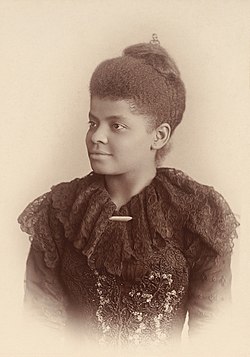- Afro-American Historical Family Record (1899)
- "I, Too": The last page [37] of Langston Hughes' 1926 poetry collection Weary Blues ; lines from this poem—noted for its intertextuality with Whitman's "Song of Myself"—are engraved on the wall of the National Museum of African American History and Culture [38]
- A poll tax is an optional local tax. A person had to pay it to be allowed to vote. The poll tax was designed to discourage certain people from voting, such as married women without separate bank accounts. [39] As late as 1940, eight Southern states made payment of poll taxes a requirement for voting. [40] This form of disenfranchisement was legal, in part because for decades after Reconstruction, the U.S. Supreme Court "closed its eyes to the use of the white primary, literacy tests, the poll tax, and other devices to deny black citizens the vote." [41] Poll taxes were prohibited in 1964 by the Twenty-fourth Amendment to the United States Constitution
- Reconstruction brought new constitutional questions to the fore, in this case, Fourth Amendment limits on search and seizure ("Military Arrest," The Daily Phoenix, South Carolina, October 7, 1866)

The African American founding fathers of the United States are the African Americans who worked to include the equality of all races as a fundamental principle of the United States. Beginning in the abolition movement of the 19th century, they worked for the abolition of slavery, and also for the abolition of second class status for free blacks. Their goals were temporarily realized in the late 1860s, with the passage of the 13th, 14th, and 15th amendments to the United States Constitution. However, after Reconstruction ended in 1877, the gains were partly lost and an era of Jim Crow gave blacks reduced social, economic and political status. The recovery was achieved in the Civil Rights Movement, especially in the 1950s and 1960s, under the leadership of blacks, such as Martin Luther King and James Bevel, as well as whites that included Supreme Court justices and Presidents. In the 21st century scholars have studied the African American founding fathers in depth. [1] [2] [3]
Contents
- Reconstruction
- Politics of Reconstruction
- Reconstruction as Second Founding of the United States
- Organizations
- The Liberator
- American Anti-Slavery Society
- NERL
- Union League
- Niagara Movement
- NAACP
- LDF, the NAACP Legal Defense and Educational Fund
- Activists
- Richard Allen
- James Forten
- Frederick Douglass
- Henry McNeal Turner
- Ida B. Wells
- Booker T. Washington
- W.E.B. Du Bois
- Thurgood Marshall
- Evaluating the original Constitution
- Additional images
- See also
- Notes
- Further reading
- Primary sources
- External links





